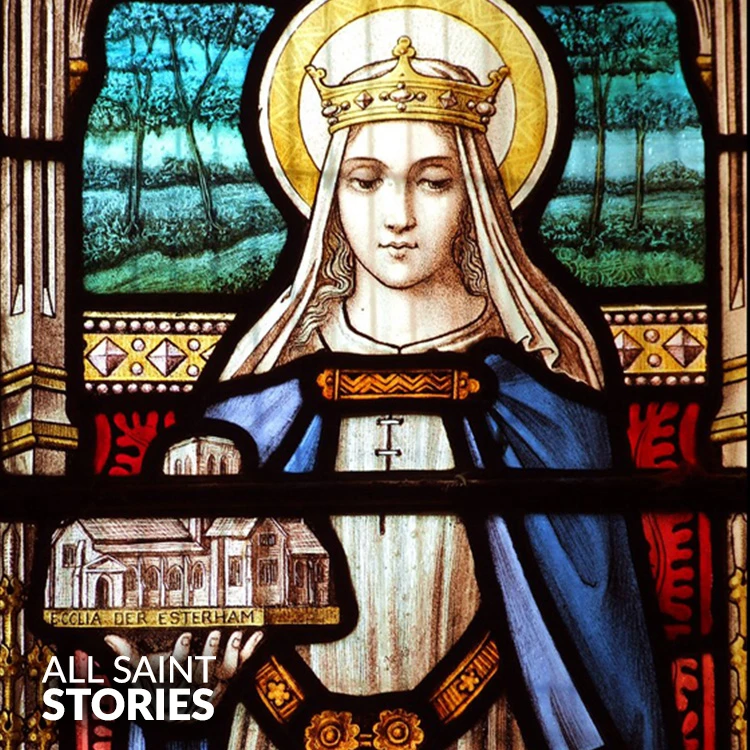Saint Withburga, devoted servant of God, Guide us with your wisdom and gentle strength. Help us to live with faith, humility, and love, And intercede for us, that we may grow in holiness. Through your example, inspire us to trust in God's plan. Pray for us, that we may find peace and joy in His presence. Amen.
ST. WITHBURGA
ST. WITHBURGA

St. Withburga was an Anglo-Saxon princess and nun who founded a monastery at Dereham, England, in the 7th century. She lived a life of prayer and asceticism, dedicated to serving God. After her death, her body was reportedly found incorrupt, and her relics were later transferred to Ely. Her legend includes a miraculous well that sprang forth at her tomb. She is honored on March 17.
St. Withburga was a 7th-century Anglo-Saxon princess and the youngest daughter of King Anna of East Anglia, who was known for his piety and whose family produced several saints, including her sisters, St. Ethelreda, St. Sexburga, and St. Ethelburga. Raised in a royal court deeply influenced by Christian faith, Withburga developed a strong desire to dedicate her life to God from an early age.
Withburga chose to live as a nun and founded a monastery at Dereham in Norfolk. She settled there with a small community of women and dedicated herself to prayer, penance, and the monastic life. According to tradition, while the monastery was being established, Withburga and her companions suffered from a lack of food. One night, the Virgin Mary appeared to her in a vision, promising divine help. The next morning, two wild deer came to the nuns' settlement and allowed themselves to be milked, providing sustenance for the community. This miracle was seen as a sign of divine favor and further encouraged Withburga and her sisters in their holy work.
She spent her life in humility and devotion, living an austere existence and fostering a spiritual atmosphere within the community. Withburga’s influence extended beyond her monastery, as people from surrounding areas sought her guidance and prayers. She was regarded as a model of Christian virtue, inspiring many to embrace a deeper spiritual life.
After her death around 743, Withburga was buried at Dereham. Years later, when her tomb was opened, her body was found incorrupt, a sign of holiness in medieval Christian belief. Her resting place became a pilgrimage site, attracting many visitors who sought her intercession. A well, known as "Withburga’s Well," was said to have miraculously sprung up at the site of her original grave, and its water was believed to have healing properties.
However, in the late 10th century, the monks of Ely, where Withburga’s sister St. Ethelreda was also buried, sought to transfer her relics to their abbey. The story goes that the monks stole her remains from Dereham under the cover of night and brought them to Ely, where they were enshrined alongside her sisters. This act, though controversial, ensured Withburga's veneration continued at Ely, which became one of the most important monastic centers in medieval England.
St. Withburga’s legacy as a holy woman and monastic founder continued for centuries. The well at Dereham remained a place of pilgrimage, and her story was recorded by medieval chroniclers as part of the rich history of East Anglian Christianity. Although her monastery at Dereham no longer exists, her name is still remembered, and she is honored as one of England’s early female saints.
Her feast day is celebrated on March 17, and she remains a symbol of faith, monastic devotion, and divine providence. Her story, marked by miracles and unwavering commitment to God, continues to inspire those who seek to live a life of prayer and service.
Video Not Found
The information on this website is compiled from various trusted sources. While we aim for accuracy, some details may be incomplete or contain discrepancies.
If you notice any errors or have additional information about this saint, please use the form on the left to share your suggestions. Your input helps us improve and maintain reliable content for everyone.
All submissions are reviewed carefully, and your personal details will remain confidential. Thank you for contributing to the accuracy and value of this resource.
Credits & Acknowledgments
- Anudina Visudhar (Malayalam) – Life of Saints for Everyday
by Msgr. Thomas Moothedan, M.A., D.D. - Saint Companions for Each Day
by A. J. M. Mausolfe & J. K. Mausolfe - US Catholic (Faith in Real Life) – Informational articles
- Wikipedia – General reference content and images
- Anastpaul.com – Saint images and reflections
- Pravachaka Sabdam (Malayalam) – Saint-related content and insights
We sincerely thank these authors and platforms for their valuable contributions. If we have unintentionally missed any attribution, please notify us, and we will make the correction promptly.
If you have any suggestion about ST. WITHBURGA
Your suggestion will help improve the information about this saint. Your details will not be disclosed anywhere.
© 2025 Copyright @ www.allsaintstories.com




 English
English
 Italian
Italian
 French
French
 Spanish
Spanish
 Malayalam
Malayalam
 Russian
Russian
 Korean
Korean
 Sinhala
Sinhala
 Japanese
Japanese
 Arabic
Arabic
 Portuguese
Portuguese
 Bantu
Bantu
 Greek
Greek
 German
German
 Dutch
Dutch
 Filipino
Filipino